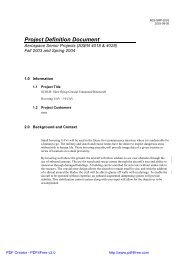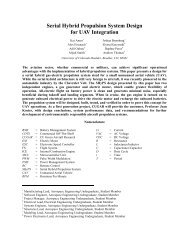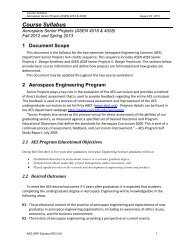PFR - Aerospace Engineering Sciences Senior Design Projects ...
PFR - Aerospace Engineering Sciences Senior Design Projects ...
PFR - Aerospace Engineering Sciences Senior Design Projects ...
Create successful ePaper yourself
Turn your PDF publications into a flip-book with our unique Google optimized e-Paper software.
Project Final Report – CUDBF April 30 th , 2009<br />
ASEN 4028: <strong>Aerospace</strong> <strong>Senior</strong> <strong>Projects</strong><br />
In order to isolate the cause of the motor failure, the propulsion system was bench tested on the<br />
ground after the flight. It was determined that there were no issues with the motors, speed<br />
controllers, or wiring. The problem was determined to be a receiver issue. The receiver used on<br />
this flight was a 72 MHz receiver instead of a 2.4 GHz receiver, which will be used at<br />
competition. During bench testing, there was significant interference noticed with the 72 MHz<br />
receiver. The possible cause of the crash was suspected to be from the faulty receiver which<br />
caused the motor to cut out in flight. The 72 MHz receiver was replaced with the 2.4 GHz<br />
receiver. There were no receiver issues after replacing the receiver.<br />
13.2.2.4 Flight Test #5<br />
Flight test #5 was another flight dedicated to getting the pilot used to flying the aircraft. During<br />
this flight, the aircraft experienced servo travel on the right elevator. The right elevator was<br />
deflected up about 20° while the pilot commanded neutral elevator. The red arrow shown in<br />
Figure 125 shows the deflection experienced in flight. The pilot aborted landing twice before<br />
being able to force the aircraft on the ground during the third attempt. After the flight, it was<br />
determined that the servo travel occurred because the servo was over-torqued.<br />
Figure 125: Elevator servo travel experienced on flight test #5<br />
During analysis, the worst case scenario torque calculated for the elevator servo was 92 oz/in.<br />
This would only occur at the aircraft top speed of 70 mph, and a full control surface deflection of<br />
25°. However, it was determined that the pilot would never use full control deflection at top<br />
speed. Therefore, a lower torque servo was used in order to save weight. The servo torque of<br />
48.6 oz/in was used since it still allows for 20° of deflection at 60 mph. However, this torque<br />
proved to be insufficient through flight testing. Therefore, the next size up in servos was chosen,<br />
providing 66.7oz/in of torque. This allows for full 25° elevator deflection at up to 60 mph, and<br />
up to 20° of elevator deflection at the top speed of 70 mph.<br />
141
















